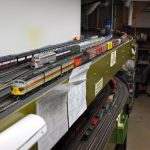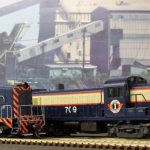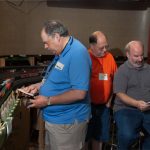Illinois & St. Louis Railroad  and subsidiary Central Illinois Terminal & Transfer
and subsidiary Central Illinois Terminal & Transfer
Location: Lee, Illinois (near Rochelle and about a half hour south of Rockford city limits)
CEO: Mike Schafer (Rockford native and former member, 1963–1967, of the late, lamented Forest City Model Railroad Club); “Look Both Ways” columnist for Railroad Model Craftsman
The I&StL is up and running and I am planning op sessions as often as feasible during 2017, including during the summer months.
Scenery continues to be high on the list of ongoing projects on the Illinois & St. Louis along with signaling. If anyone out there knows of a good, cheap, fast method of painting wheelsets for resistance for block detection, I’m all ears. Generally, we have work sessions every other Friday night unless otherwise noted. The next work session is Friday June 30, 2017, and you can calculate from that when following work sessions are planned.
Do NOT be intimidated by my slightly overblown layout. We’re here to have fun and learn some things about 1960s Midwest railroading. Greenhorns are welcome! We have work sessions on Friday nights, alternating with work sessions at Mike McBride’s 2,000-square-foot Chicago & North Western/Litchfield & Madison/Louisville & Nashville layout in Dixon, Ill. Both of us welcome help.
I would like to host an operating session expressly for other RockRail members. My sessions tend to “sell out” quickly via word of mouth before I can get them posted on the RockRail site. So, I’d like to get a poll from RockRail members to do a special session for just us RockRail guys.
Format: Free-lanced prototype, 1965-66
Stats: 1,600 square feet; double deck; combination L-girder, grid, and stud-and-wall, and slight “mushroom” benchwork; approx. 1,000 route-feet of main line; Easy DCC control; fast clock (2:1); loads of switching, industrial and yard, with card waybilling based on John Swanson’s Dixon, Wyanet & Lake Superior. Dispatching is via CVAS (Centralized Verbal Abuse System). There is a real railroad next to house for idle I&StL crews awaiting their next call, so bring your camera!
Railroads integral to the operation (i.e., other railroads modeled on the layout): Illinois Terminal; Illinois Central; Erie Lackawanna; Nickel Plate; Pennsylania; Gulf, Mobile & Ohio; Santa Fe; Toledo, Peoria & Western; Indiana Harbor Belt; Elgin, Joliet & Eastern, Rock Island; Belt Railway of Chicago; Baltimore & Ohio Chicago Terminal; Monon; Chesapeake & Ohio; Peoria & Eastern; Chicago & Illinois Midland; Chicago & Eastern Illinois; Wabash; Chicago, Burlington & Quincy.
The I&StL—and our regular crews pronounce it the “I and Saint L” (still others call it the “Insolvent & Still Losing”)—is a typical Midwestern also-ran carrier trying to make it in a world still full of regulation and tried-and-proven steam-era railroading methodology. Until I get a map onto the website, you’ll have to visualize the width and breadth of the railroad (if you have a copy of Tony Koester’s MODEL RAILROAD PLANNING 2005, there is a map of the I&StL within and a complete track plan). The principal mainline runs from Minneapolis/St. Paul to Cincinnati via Madison, Rockford, Dixon, Peoria, Bloomington/Normal, Champaign, and Indianapolis. This route also has an extension into Chicago from Rockford. The other principal mainline runs from Chicago to St. Louis via Joliet, Peoria, Lincoln, Springfield, and Edwardsville. There is also a mainline segment from Champaign to Springfield.
The railroad acts largely as a Chicago bypass, with much traffic entering the system eastbound at the Twin Cities via connecting carriers Great Northern, Northern Pacific, and Soo Line, and then leaving the system at Indianapolis for the East via the B&O, PRR, and NYC; traffic for the Southeast travels through the Cincinnati gateway where connections are made with Louisville & Nashville, Southern Railway, and Chesapeake & Ohio. And vice versa.
The Chicago–St. Louis main line acts as a conduit for traffic out of the Southwest off the Frisco, Missouri Pacific, and Cotton Belt, with much of that traffic destined for the EL (I&StL’s main ally), NKP, B&O, NYC, and PRR. And vice versa there, too. And, both mainlines, which essentially cross at Peoria, provide traffic for the Peoria Gateway, with through traffic to/from the TP&W, IT, NKP, CB&Q, IC, CRI&P, PRR, and P&E as well as to Peoria, East Peoria, and Pekin’s many industries.
The I&StL is very pro-passenger and therefore operates a number of passenger trains that are still well-patronized by 1965 standards. Once complete, Central Station in Peoria will alter many a perception that passenger trains on a layout simply roll onto the layout and then off into staging with nary a whimper. If you think that, I’m going to assign you as stationmaster at 3 a.m. when both the northbound and southbound Prairie Sentinels (Chicago–St. Louis overnighters) arrive Central Station, pick up/drop off their Peoria sleepers, set-out/pick-up blocks of mail and express cars, and combines/splits with the Peoria–Rockford sections.
Of course, I don’t have room to model the whole I&StL. What you will find modeled is part of the Chicago Terminal District, Joliet (including its famous 16-diamond intersection at Joliet Union Station), Peoria, East Peoria, Pekin, and the mainline as far south as Springfield; the Twin Cities–Cincinnati mainline is modeled from Bureau Junction to Champaign. Peoria/East Peoria is the heart of the railroad. Also modeled is the joint Santa Fe-GM&O mainline from Joliet to Coal City, active with operating Santa Fe and GM&O “scenery trains.”
Although the I&StL remains a work in progress, we have been holding operating sessions now since the mid-2000s. Despite the fact that Bob Wegner’s splendid trackplan of my railroad in MRP 2005 makes it look completed, it is not. The main level is complete in terms of trackage and operation (save for completed engine terminals at Chicago and Peoria), but Phase II is only recently and actively under way: the laying of mainline track, yards, and the Pekin Branch up to and through the second level (all benchwork is in place, however).
I hold work sessions every other Friday evening here at the I&StL in Lee (near Rochelle), alternating with Friday evening work session’s on Mike McBride’s stellar C&NW/Litchfield & Madison layout in Dixon. With work sessions in Lee, we usually meet for supper somewhere at 6 p.m., either at Coupe’s Bar & Grill in Lee, Chumley’s Pizza in Shabbona, or at the best Italian restaurant in the region, Aldo’s in downtown Rochelle. Work sessions that start around 7:30 p.m. You don’t have to attend the supper thing. We will try to assign you to tasks in which you feel you excel (i.e., tracklaying, scenery, planning, kit assembly, etc.) A railroad this size cannot be done by just one person. Many friends have helped make the I&StL a reality, and we welcome you to become a part of that circle.
Operating sessions are nearly always held on Saturdays as announced and usually begin at 1 p.m. (newbies are asked to come an hour earlier for orientation) and last about 4-1/2 hours. Those who have at least semi-regularly helped with the layout’s planning and construction or donation of rolling stock have seniority when it comes to first choice of assignments at the start of an operating session. Generally, we need about a dozen people minimum for current operating sessions, but as more of the layout is completed, we will be needing even more operators.
—Mike Schafer
P.O. Box 129
Lee, IL 60530
mschaf4001@earthlink.net



